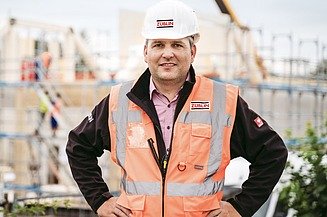One of the most sustainable university buildings in Germany

How it all began...
The project kicked off in August 2019, preceded by our acquisition department. The special feature: this was a quality competition, not a price competition as usual. The entire building was to be based on wood, entirely in the spirit of sustainability. In our planning, we therefore already started at phase 0 and were thus able to win the competition.
What is special about timber construction in general?
Wood is a natural raw material and one of the central building materials that grow again. Each cubic meter of wood used can bind up to one ton of climate-damagingCO2 from the atmosphere. In addition, wooden elements provide a natural indoor climate. With the project for the University of Witten/Herdecke, we have fully exploited the potential of the wood hybrid construction method. The special feature or challenge here: timber construction thrives on detail. This means that the preliminary planning has to be very concrete and fixed at a very early stage. Due to the prefabrication of the parts in our own factory, a relatively rapid construction process is possible. The shell was completed in just nine weeks, and the entire building was ready after a total of 18 months.
How is sustainability defined in concrete terms in the new campus building?
The use of sustainable building materials plays an important role in reducingCO2 emissions in construction. The new building project in Witten specifically used products, technologies and processes that conserve resources and are energy-efficient. The technical building equipment for the new building was designed according to the low-tech energy concept. This involves minimizing the building's energy consumption without using complex technical systems. In the spirit of sustainability, our team developed an individually optimized heating, cooling and ventilation concept for the appropriate use of space in combination with the facade in an integral planning process. The premises can also be flexibly and quickly adapted to different usage requirements. We have already taken into account the possibility of connecting the new building to the existing buildings at a later stage in the planning and construction.
What were your tasks and what do you appreciate most about your work?
My tasks included organizing the construction site and liaising with clients, planners and authorities. In short: coordinating the whole thing. What I particularly enjoy is being able to help shape things, make decisions and bear responsibility - which can be a curse and a blessing at the same time. Of course, it's always great to lead by example and set standards, in our case in terms of sustainability.
What challenges did you overcome together?
Shortly after the construction site was set up, Corona arrived. Many teams had to move to the home office on an ad hoc basis and all communication was moved to digital. That was a challenge for all of us, but we mastered it well as a team. In mid-2020, we returned to the construction site with our team. During the tight construction period, we often had to contend with the reservations of the authorities in North Rhine-Westphalia, as timber construction is less widespread there.
Now to your personal career path: What did it look like?
I've been involved with wood almost all my life, since I was 15 years old to be precise. After graduating from school, I completed an apprenticeship as a carpenter and then further training to become a master carpenter. I then went on to study civil engineering. I then started my career in the Group as a specialist in structural planning, after which I progressed from construction management at ZÜBLIN to project management and finally to senior construction management. Since January 2022, I have been the Technical Division Manager.
Was there a personal highlight for you in this project?
The whole project in itself. Projects like the new building at Witten/Herdecke University should not remain stand-alone beacons. Rather, it is important to set standards here and now and thus redefine building as a whole. As a sustainable, flexible building material, wood offers immense potential that we want to and must use on the path to climate neutrality. In Witten, we have shown how much is already possible today.